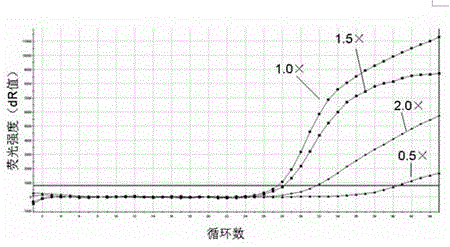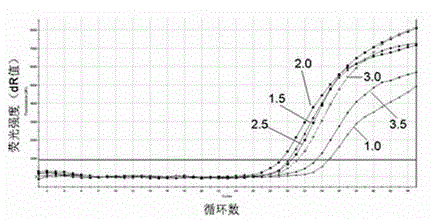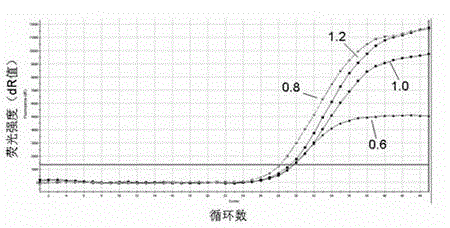Primer pair and probe used for detecting AIDS treatment medicine 3TC and FTC drug-resistance mutation sites and application thereof
A technology for drug resistance mutation sites and therapeutic drugs, applied in the field of biomedicine, can solve the problems of long time consumption, high detection cost, poor specificity, etc., and achieve the effects of simple operation, high sensitivity and low cost
- Summary
- Abstract
- Description
- Claims
- Application Information
AI Technical Summary
Problems solved by technology
Method used
Image
Examples
Embodiment 1
[0071] Preparation and screening of the main components of the detection kit for AIDS treatment drug 3TC and FTC resistance mutation sites:
experiment example 1
[0073] The cDNA sequence of HIV-1 pol RT gene is shown in SEQ ID No.14. According to the mutation types of the four point mutations M184V, M184I, Q151M and K65R, primers and probes for RT-ARMS-Taqman qPCR were designed using Primer premier 5.0 software, so that the mutation site was located at the last position of the upstream or downstream primers, and the Missense mutations were carried out at the 1-2 bases upstream of the mutation site. The specific primer probe sequences are shown in SEQ ID No. 1 to SEQ ID No. 10.
[0074] Two point mutations, M184V and Q151M, were introduced into the HIV-1 pol RT gene by artificial synthesis to obtain the mutant positive control substance 1, whose sequence is shown in SEQ ID No. 15. The synthetic HIV-1 pol RT mutant positive control substance 1 containing two point mutations of M184V and Q151M was cloned into the pGM-T vector to construct a recombinant plasmid, and then the recombinant plasmid was transformed into DH5α Escherichia coli, ...
experiment example 2
[0081] Use the primer probes SEQ ID No. 11, SEQ ID No. 12, and SEQ ID No. 13 of the quality control product of the kit as the primer probe pair, and use the negative control prepared above as a template after dilution for RT-ARMS-Taqman qPCR. MgCl in PCR reaction 2 The concentrations were 1.5mM, 2.0mM, 2.5mM, 3.0mM and 3.5mM, and the concentrations of the other components were the same (the final concentrations of each component in a 20μL system were 1×RT-PCR buffer, 0.8 mM dNTPs, 1.6 U / μL M-MLV reverse transcriptase, 0.04 U / μL TaqDNA polymerase, 200nM primers, 100nM Taqman probe, 0.1-10ng / μL positive control). The PCR reaction conditions were: reverse transcription at 42°C for 30 min, one cycle; pre-denaturation at 95°C for 3 minutes, one cycle; 40 amplification cycles, deformation at 95°C for 10 seconds, annealing and extension at 55-60°C for 30 seconds. The result is as figure 2 shown. Depend on figure 2 It can be seen that in MgCl 2 There are amplification curves ...
PUM
 Login to View More
Login to View More Abstract
Description
Claims
Application Information
 Login to View More
Login to View More - R&D
- Intellectual Property
- Life Sciences
- Materials
- Tech Scout
- Unparalleled Data Quality
- Higher Quality Content
- 60% Fewer Hallucinations
Browse by: Latest US Patents, China's latest patents, Technical Efficacy Thesaurus, Application Domain, Technology Topic, Popular Technical Reports.
© 2025 PatSnap. All rights reserved.Legal|Privacy policy|Modern Slavery Act Transparency Statement|Sitemap|About US| Contact US: help@patsnap.com



